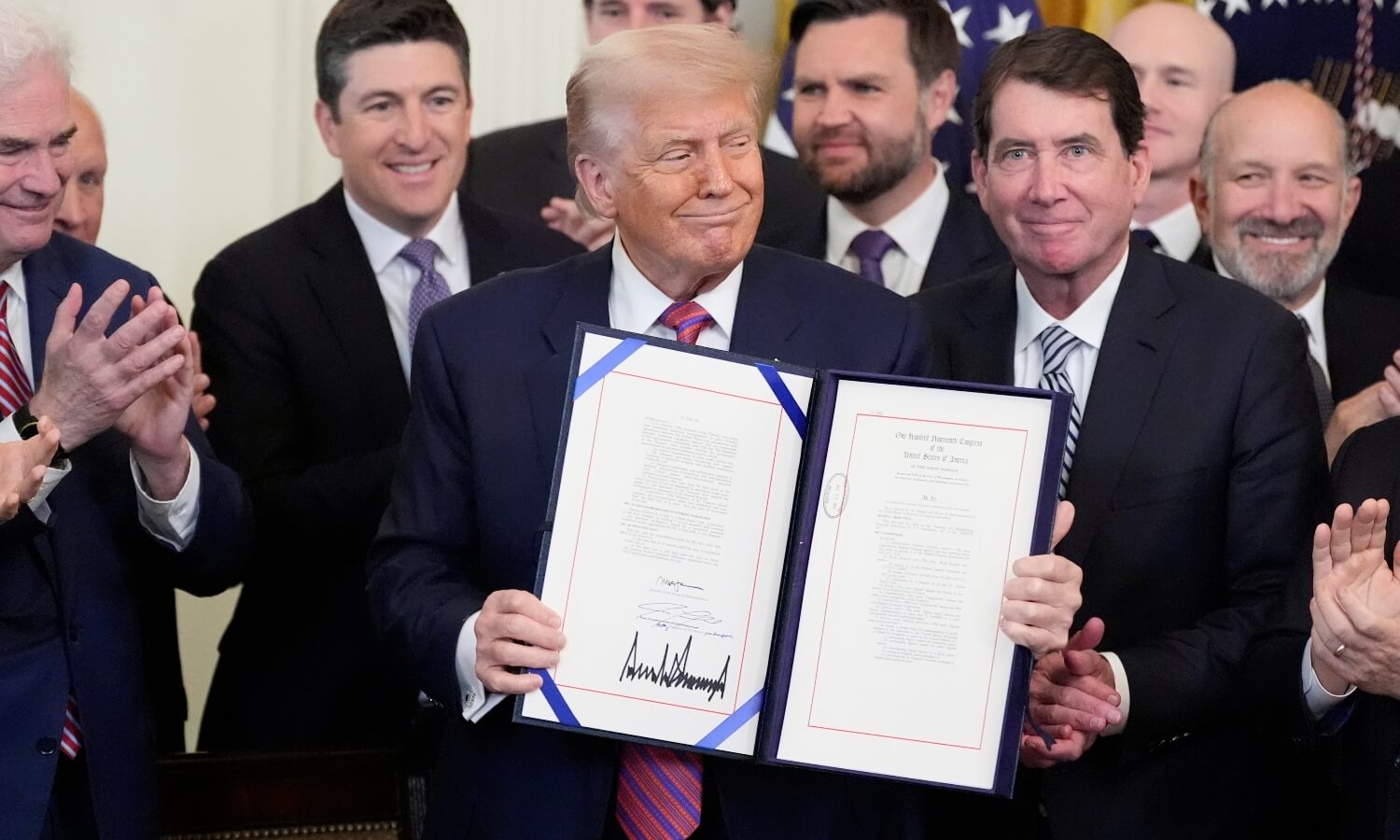There have been increasing calls to simplify the rules to make it easier to launch Canadian-dollar linked stablecoins, and stem the potential outflow of capital from the country. “At a minimum, from a sovereignty perspective, Canadians should want a Canadian stablecoin,” said Didier Lavallée, chief executive of digital assets company Tetra Digital Group.
U.S. stablecoin dominance puts pressure on Canada
Concerns have risen since the United States passed legislation this past summer that establishes clear rules around the sector, and further entrenched U.S.-dollar dominance in the space that touts faster and cheaper money transfers.
Because stablecoins are meant to reflect the value of conventional currencies, issuers need to buy hard assets like dollars to back them up. No Canadian-dollar pegged stablecoins means more money flowing out of Canada, and into U.S. dollars and U.S. government bonds.
“Canada should also weigh the merits of federal stablecoin regulation,” said Ron Morrow, executive director of payments at the Bank of Canada, in a September speech.
His former colleague Timothy Lane, who stepped down as deputy governor in 2022, was a little more blunt in an October report for the Global Risk Institute. “Stablecoins are becoming too important to be ignored,” said Lane. “There is now an increasing sense of urgency about establishing a coherent framework for regulating stablecoins in Canada.”
Peter Routledge, head of Canada’s banking regulator, has also said he’s worried about the fast moving space and will be watching the budget closely on Nov. 4, while John Ruffolo, managing partner at Maverix Private Equity, has been one of the most outspoken in the need to respond.
One of Ruffolo’s biggest worries is that some people and businesses could start to leave money in the stablecoin sphere, rather than in bank deposits. That’s already how stablecoins first gained traction: as a stable place for crypto-traders to park money between bets, without having to exchange it back into conventional currencies.
Given banks use deposits as an anchor for lending, he’s warned that even if 5% of Canadian bank deposits, or some $135 billion, went into U.S. stablecoins, it would have a knock-on effect of erasing as much as $675 billion in domestic lending capacity.
Private sector leads Canada’s stablecoin push
The rising calls have increased expectations of some movement from the federal government, but given how slowly past promises like open banking have actually rolled out, some companies like Tetra aren’t waiting around for change before pushing ahead with their own stablecoins. “Financial innovation in this country takes quite a long time,” said Lavallée.
Because Tetra is already registered as a Canadian trust company, Lavallée sees an easier road than others to getting regulatory approval through the current system. Tetra’s efforts have also had a boost from major backers like Wealthsimple, National Bank, ATB Financial, and Shopify, which chipped in on a $10 million financing to help ready a stablecoin for release aimed at early next year.
The best crypto platforms and apps
We’ve ranked the best crypto exchanges in Canada.
Elsewhere, Transactix Financial Inc. announced plans in May to move forward on its own token, and just last week Loon Technology Inc. announced it had raised $3 million to get its own Canadian-dollar stablecoin going.
The companies are all working to navigate an existing system that some, at least, aren’t so concerned about. “I think it’s working well,” said Grant Vingoe, head of the Ontario Securities Commission that’s taken a lead role in stablecoin oversight.
Uptake and impact of stablecoins still unclear
While the U.S. has used legislation, Canada’s approach to working with each issuer is more adaptable in the fast-moving crypto space, he said. “There’s a lot to be said for a more tailored, direct engagement approach, where you express your concerns and requirements … rather than try and codify it once and for all.”
So far that approach has yielded a single issuer, Circle, getting the blessing of regulators for its U.S. dollar-pegged stablecoin.
But Vingoe is also still skeptical about how much uptake there will actually be for stablecoins. “I think it’s still an open question whether stablecoins will be used extensively as a payment mechanism.” Improvements to the existing payment system could end up being better or more efficient, he said.
Some have pointed to central banks possibly issuing their own digital currencies, though the Bank of Canada has shelved work on such efforts.








